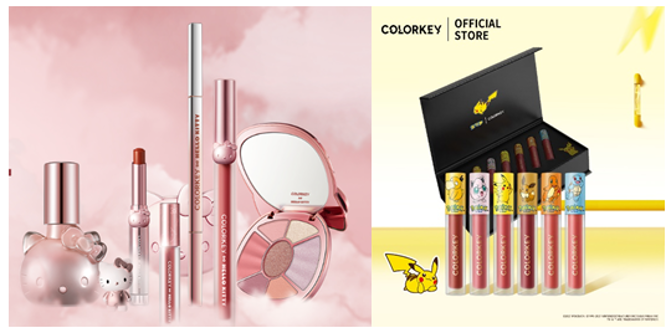China is the largest market for skin care and second largest for colour cosmetics, with a combined market size of USD49 billion in 2022. Increasing consumers’ confidence in domestic brands helped solidify C-beauty brands, which accounted for four of the top 10 brands in China’s skin care market in 2021. Rapid new product development, consumer participation and “social selling” (livestreaming) are just some of the strategies that give C-beauty brands an edge. Since per capita consumption in China reached USD29 in skin care but only USD6 in colour cosmetics, there are ample opportunities for C-beauty to leverage post-COVID-19 recovery throughout 2023.
Five secrets behind the popularity of C-beauty
1. Improving product quality, not just as a cheaper substitute for foreign brands
In the past, consumers perceived C-beauty as the “cheaper substitute” for foreign brands. But traditional C-beauty brands such as Chando or Herborist have shown new potential through product development and strategies targeting younger generations, while emerging new brands such as Winona, Zhuben or Florasis have pushed ingredient and format innovation.
Skin care brand Winona teamed up with dermatologists and used unique botanical ingredients to develop innovative formulas for sensitive skin. It is not an overstatement to say that Winona opened a new era of ingredient-led skin care in China, where 14% of the consumers sought out sensitive skin suitability when purchasing skin care in 2022.
To leverage C-beauty momentum, even former B2B raw material suppliers have transformed to B2C brand operators. Bloomage Biotech, the world‘s leading cosmetic raw material supplier, has successfully utilised its well-established supply chain of hyaluronic acid to build its private brands, Biohyalux and Quadha, offering cost-effective products directly to consumers.

2. Rapid new product development to capture a volatile market
When it comes to product development, C-beauty brands are adept at creating the hit product and radiating the reputation from one SKU to the brand. This approach allows them to concentrate and leverage limited resources during the initial stage. Good examples are Florasis loose powder, Colorkey lip gloss or Zhuben cleansing oil. These products became hero products in their subcategory first, and made the brand stand out later.
C-beauty brands also stimulate users’ demands with rapidly recurring new product launches. Perfect Diary updates its product offerings every half year for all the main categories and every quarter for the subcategories. The speed is much faster than the international brands, which usually take 7-18 months.

3. Being flexible and responsive to consumers’ feedback
Florasis invited around 200,000 consumers as “experience officers” to try new products before and after their launch. An eyebrow pencil product went through seven rounds of optimisations over four years, reflecting consumers’ feedback. Zhuben, in collaboration with beauty social platform Bevol, tested a repairing oil product with over 1,400 consumers and analysed user experience in four dimensions before launch. Traditionally, before-launch tests are conducted mainly for safety and efficacy evaluations, and the number of testers is usually less than 50 due to the high recruitment cost. New C-beauty brands recruit consumers at a lower cost with their influence on social media, which has created an innovative way as co-creation with consumers.
4. Specialising in e-commerce channels
Specialisation in e-commerce has contributed to the growth of C-beauty brands. Unlike traditional brands that used to reach consumers through store-based channels, new C-beauty brands use e-commerce as the main stage to attract young consumers with growing purchasing power.
According to Euromonitor International, the e-commerce penetration rate of beauty and personal care products in China was 43% in 2022. E-commerce as a marketing and sales channel now plays a decisive role for new brands. To win in such a fierce online market, brands need to make better use of big data, such as consumer online behaviours, to precisely reach and continuously optimise the offerings.

Winona launched anti-ageing serum, collaborating with Tmall Little Black Box, a strategic product development platform based on Alibaba’s big data and merchandiser’s selection.
5. Seizing the opportunities in digital marketing and live commerce
C-beauty brands utilise the emerging influence of live commerce (also called “social selling” or “livestreaming”) by in-depth cooperation with KOLs. A large part of the sales of C-beauty brands are generated by the live commerce of top influencers, especially during the 11.11 and other shopping seasons. Sometimes, the sales brought by top influencers can even exceed half the annual sales. With international brands also participating in this area, live commerce has become a mainstream shopping channel.

Florasis’s winning strategy is to co-create products with KOLs. The brand rapidly captured the No.1 spot in loose powder on Tmall, which could not be done without the promotion by top influencer Austin Li Jiaqi.
C-beauty brands’ long-term development faces challenges
Becoming more digitally efficient will contribute to C-beauty brands competing on a more level playing field with multinational companies that have spent decades developing expertise. To achieve an intelligent supply chain and maximise warehouse usage and inventory, Chando by Jala Group realised the need to digitalise its system and unify inventories previously scattered among distributors in different cities.
C-beauty brands’ rapid product development and mastery of digitalisation have enabled them to capture the market quickly. However, with the tightening of live commerce regulations, it as a single channel cannot provide sustainable growth. C-beauty brands need to find a long-term branding model to connect with consumers.
Brands need to also expect more fragmentation—and fiercer competition—from fellow C-beauty players, given that from 2017 to 2021 the share of the top 10 C-beauty brands in colour cosmetics increased from 15% to 27%. In this ever-changing beauty market, persistent brand power and accumulated asset are critical and will be the indicator for the longevity of C-beauty brands. For the coming year, the end of zero-COVID in China will accelerate the market recovery, which gives C-beauty brands a timing to seize the growth trend that generated from pent-up demand.
For further insight, read Euromonitor International’s report, Beauty and Personal Care in China.

